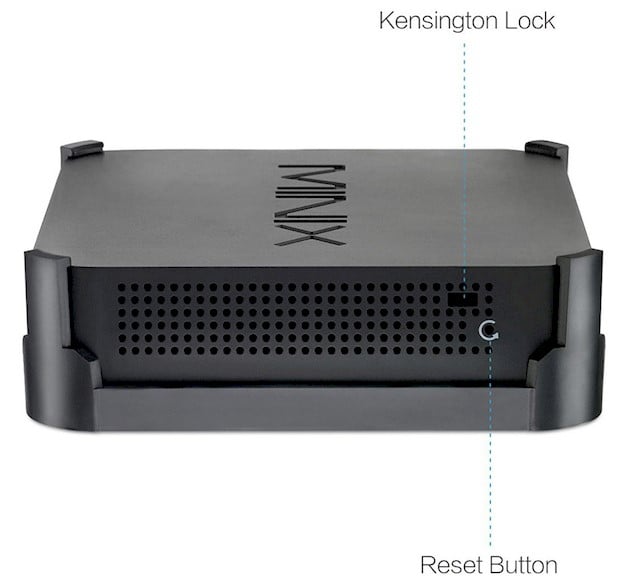The MINIX Neo N42C-4 isn't the
smallest PC we have tested, but it is miniscule by most standards. It’s roughly 5.5” square and about 1.25” high, though its corners are rounded which make it appear a bit smaller. With the exception of the accommodations for its various ports, the MINIX Neo N42C-4 also features a completely sealed enclosure with some perforations for ventialtion. The enclosure has a very dark-grey, essentially matte black finish, with the MINIX logo etched into the top and the only color coming from the blue USB ports and power LED.
Because the quad-core
Intel Pentium N4200 and other components inside the Neo N42C-4 are somewhat more powerful than some of MINIX's previous mini machines, this one isn't passively cooled. There is a single internal fan that helps cool the internal components, but thankfully it remains mostly silent. Even when it does spin up, it's very quiet and difficult to hear.
The Intel Pentium N4200 CPU inside the device has a base clock of 1.1GHz, turbo clock of 2.5GHz, 2 MB of L2 cache, and a TDP of only 6W. Graphics comes by way of an integrated
Intel HD Graphics 505 engine with 18EUs, and base / burst frequencies of 200MHz / 7500MHz, respectively. There’s also a single-channel of 4GB of DDR3L-1600 memory inside, along with 32GB of Samsung eMMC solid state storage. Though, there is an open SO-DIMM slot inside for dual-channel operation, which would increase performance somewhat. In addition, this little system also has an open SATA
M.2 slot inside that supports drives up to 512GB.
In terms of connectivity, there’s quite a bit going on here. On the front of the device, there are three full-sized USB 3.0 ports and a power button. The right side is mostly blank, except for a tiny blue power LED. The back-side has a hidden reset button and lock port. And the left is home to the power port, an RJ-45 Ethernet port, a mini-DisplayPort connector, an
HDMI port, a USB-C port, and a 3.5mm headphone jack. Internally, there's also an Intel wireless controller with 802.11ac dual-band WiFi and Bluetooth 4.1 support.
Overall, the MINIX Neo N42C-4's design language is modern and attractive, and mostly understated. Even the bottom of the device is relatively clean, save for a quartet of rubber feet and some decals with the Windows log and model number and serial information.
The MINIX Neo N42C-4 also includes a full 64-bit edition of Windows 10 Pro, pre-installed. Most machines in this class include Windows 10 Home, but MINIX went with Pro on this device in response to customers who wanted SFF machines that could join a domain. Like previous MINIX machines, setting this one up was as simple as connecting power, input devices, and a monitor, turning it on, entering some basic user information for Windows login purposes, and then letting the OS run a few updates. There’s no bloatware or other included software to speak of – the system is as clean as could be when first powered up.
One potential problem with the paltry 32GB of internal storage is that after updating Windows and installing things like Kodi, there’s only about 15GB left available. That’s fine for an HTPC that’ll stream from a NAS or the web, and it can be easily (and cheaply) expanded with USB or the internal M.2 slot. But over time, as Windows gets continually updated, some maintenance and file decluttering will be required to keep enough space free for its solid state storage to perform optimally.










